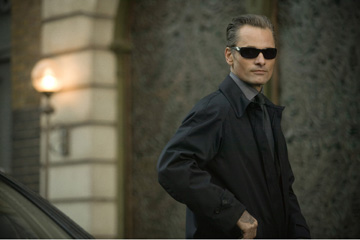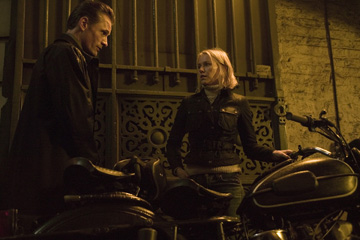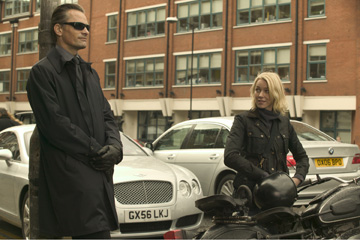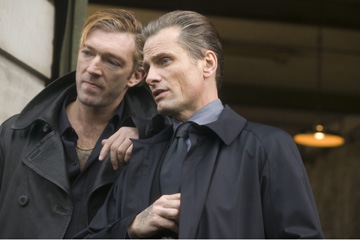Copyright ©2007 PopEntertainment.com. All rights reserved.
Posted:
September 17, 2007.
It's
entirely understandable why director David
Cronenberg has recently cast Viggo Mortensen as his lead in two
complementary but very different films (2005's excellent A History of
Violence and the new Eastern Promises). Mortensen inhabits these
characters and the characters inhabit him. It is said that when he played
Aragorn in Lord of the Rings, he didn't even notice when director
Peter Jackson addressed him by the character's name for part of a day. But
in Eastern Promises, this Oscar-bound actor has created his most
defined character yet.
This hard-nosed tale of a midwife (Naomi Watts) who become entangled with
London's Russian mob after she saves the baby of dying 14 year-old
prostitute a victim of this gang's involvement in sex-slavery could
easily have fallen into clichι and mindless adventurism in the hands of a
less skilled and unique director. But through Cronenberg, both Mortensen and
Watts have an ideal vehicle to deal with the ambiguities of two richly drawn
characters caught up in a world fraught with violence and despair.
Since his screen debut as a young Amish farmer in Peter Weir's 1985 film
Witness, the nearly 50-year old actor's career has been a steady string
of increasingly well-rounded performances in over 30 movies. Working with a
crop of A-list directors from Jane Campion (The Portrait of a Lady)
and Brian De Palma (Carlito's Way) to Ridley Scott (G.I. Jane),
Mortensen stirred attention as Diane Lane's boho lover in Tony Goldwyn's
A Walk on the Moon (1999).
Born in New York to a Danish father and an American mother, Mortensen split
his childhood between Manhattan and places like Venezuela, Argentina and
Denmark. He speaks several languages and is also an accomplished poet,
musician, photographer and painter.
So you've walked in sporting this new look (a trim goatee). What's this
all about?
It's for a Western I am doing that Ed Harris is directing.
 And what are you drinking there [he's holding a small silver pot with a
pipe attached]?
And what are you drinking there [he's holding a small silver pot with a
pipe attached]?
This is mate. It's an Argentinean tea. It's a ritual, like [smoking] peace
pipe; people drink it all day. It's very good for you, like a strong green
tea with lot of anti-oxidants.
Were you drinking mate in the movie?
There's no mate in movie but I drink all day long.
Beside mate, what else did you do to get so fit for this film?
Physically... I had to study up and learned certain fighting techniques and
defensive moves that someone like that might know. Some of them came from
Russian military training manuals and other things I just learned from other
people. I tried to get more or less in good shape; although he's not
necessarily in great [shape]... he's a guy who needed to be able to do what
I do in the movie. But he also has relatively good life, compared to his
life previously; it's a better life. Though he's not that he's making all
that much money, he's a driver for this family, it's not that he makes a
great salary but he eats well. It's sort of a balance. It should be
realistic looking.
It's not a super-hero sort of a story but it's nice to have a balance; the
people are believable, they are layered, and they are complicated like they
are in real life. They're sometimes unpredictable in a real way in a good
way. Not just my character but Naomi's character as well, they will do the
right thing in difficult circumstances, though there's really no reward. It
may be quite risky to stick your neck out for someone you don't really know
[but they do it anyway].
Did you develop a back story for your character Nikolai, since this film
has such richly layered, complex elements?
I always ask myself the same questions about what happen before page one.
Where was he born? How was he raised? How did he get there? This one was
very interesting; some characters you have the advantage of knowing more
beforehand. The only thing I really had here was my interest in [the
subject] and my curiosity; I wanted to learn to how to speak properly, to
use the right slang, to understand all that I could.
I knew how to do some of the stunt work. I could drive a car [laughs]
but I had to get used to driving a Mercedes on the wrong side of the road.
And that was sort of tricky to learn. There was a lot to learn, which makes
it fun to me; it's the things you learn before you start that you can always
count on. If the shoot isn't good or the movie doesn't turn out so well you
at least have what you have learned. It was especially good here. I met
Russian people for translating, and also people who knew the background of
the character I was playing. I went to Russia for a couple weeks before we
started which was also very helpful; to see people and to have a visual
sense and a memory of what it looked like, what it smelled like, and how
people behaved.
And did any of those Russians have tattoos?
I did meet a few of those...
 Was it difficult to learn the Russian language?
Was it difficult to learn the Russian language?
I have an advantage because I speak Spanish; the J sounds and R sounds
[makes that rolling rrrrrr and chhhh sound] they have in Russian, so I
had an advantage to copy those. But they have some vowel sounds that are
trickier and particular to Russian and other Slavic languages. I had to work
on that.
We had an excellent dialect coach, a guy named Stanislaw in Los Angeles, who
worked with us on translation. And on speaking, I met some Russians who
helped me. They said, these are good translations, but a guy with your
background, a prison background, a street background, would use this kind of
word with a double meaning, this kind of joke. Oleg was his name; he was
working with us during the
shoot a Russian actor living in London. He was very helpful in keeping us
honest and being exacting. It paid off. I met some Russian journalists who
said they were pleasantly surprised. They were accustomed to movies made
outside of Russia with Russian characters that were, at best, a pale
imitation or full of clichιs, with bad
accents and that were sometimes full of gibberish.
Did you do other research outside of the physical aspect, like talking to
some of the underage girls who were victims of the sex trade?
By the time I went to Russia I had done most of my research; in a way, I
didn't need to go. I went for two weeks and though I had people recommended
to me from different walks of life, I intentionally didn't go around with
somebody. I wanted to go by myself and get an unfiltered look at it. Like if
somebody comes to New York, I could show them around... or they may want to
stumble around on their own.
I wanted to see things on my own, to stumble around in Moscow, St.
Petersburg, and then out in the middle of the country, where I wanted to see
what impressions I got without anybody trying to make it better or worse. I
just wanted to see it. I tried to learn as much as could and I am glad I
went even though there aren't specific things, other than a good visual
sense and a memory of places I was supposed to have been, where I was born
and raised and worked in.
Well, there were some objects and some little things I had in my pockets
like the card I give the girl that's from there. There's some other little
things you never see that I had in my pockets, including that card; it was
just something I did in rehearsal. David said that was good [and he kept it
in]; I had that one card in my
pocket every day.
 Your characters in this film and in A History of Violence have
some similarities, both were part of an organized crime group. What was
different about the two roles?
Your characters in this film and in A History of Violence have
some similarities, both were part of an organized crime group. What was
different about the two roles?
Each role I play is different. I am always trying to find as many facets
because I think people are endlessly interesting. All of us are unique and
are different on any given day in any given situation. They behave
differently and react differently.
Apart from where they are from, the main difference you could point out is
that the character [of Tom Stall] in A History of Violence was trying
to convince himself to consciously forget something and pretend it was not
real. He was play-acting in that sense, whereas Nikolai, although he had
secrets, he's pretty clear on what he's doing and why. He's not deluding
himself in any way.
What's your relationship with David now?
We do have a really good shorthand. We are able to work on a set by now
and even during A History of Violence with a minimum of analysis or
questioning, and it just goes well. I can show him things and can tell
whether it's working or not without speaking about it.
The good thing about being on the same wavelength is that I can devote all
my attention to the other people in the scene, to reacting, and to being
helpful in terms of telling the story in general. It's good when you feel
safe that you're in good hands not just for the more extreme scenes in the
movie but any day's work. If you really know that the guy in charge is
intelligent, that he knows what he's doing technically, and also has that
open mind, and has a selfless way of approaching the work and is secure
about himself [then] if somebody comes up with something, whether it's a
crew member or actor, or something strange or unexpected happens, he uses
all of it. What he doesn't need he discards, and no offense is taken if we
don't agree on something; but we mostly agree on everything.
 That was an amazing fight scene in the shower. How did you work that out?
That was an amazing fight scene in the shower. How did you work that out?
It was written that way based on where it happens. I am in a steam bath.
It's logical that it took place that way and it was logical to shoot it that
way. It wouldn't make sense otherwise. David is a friend and also a
gentleman, apart from being a great artist, so he politely said "this is
what it says, what do you think about it?" Obviously we were choreographing
it in gym clothes before, but when it got to that day it seemed pretty
obvious that it's got to be done this way. I'm sure you will shoot it in a
very straightforward way.
Apart from whether one has any clothes on or not, any violence that he shows
in this movie just like with A History of Violence although some
people will say, "Ahhh, he's over the top, it's gratuitous," I disagree
completely. He's one of the most responsible filmmakers today as far as
showing violence which there's very little of compared to other movies. It
just stays with you because he shows very little of
it. It just stays with you and he's very direct about it. He shows you what
happens, and what the consequences are physically and emotionally, in some
cases; certainly he does in A History of Violence, and also here,
that makes him very honest.
Feeling safe and trusting somebody obviously helps, because then you're
going to feel awkward in a situation like that as vulnerable as you should
be but not more than that. It's not like it's a weird thing on the set,
the director's not making you additionally uncomfortable. If anything, David
was just as a goofy as ever. He'd come over and I'd be sprawled out between
cuts. "Oops, sorry." And he'd make an inappropriate joke and walk away, and
go "lets do another one." He fosters a relaxed atmosphere [that] encourages
play.
CLICK HERE TO SEE WHAT VIGGO MORTENSEN HAD TO
SAY TO US IN 2009!
CLICK HERE TO SEE WHAT VIGGO
MORTENSEN HAD TO SAY TO US IN 2017!
Email
us Let us
know what you
think.
Features
Return to the features page.